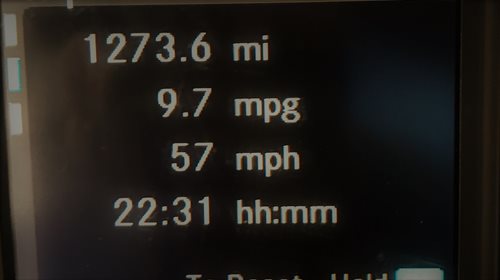 |
| This picture was taken after using the truck for two days in personal conveyance to go shopping and to the laundry mat while on a restart . the AVG. speed prior to this was 66 mph . |
As many of you know the spot market is on fire right now. Depending on your situation many factors need to be considered when choosing your cruise speed. Of course, the first factor always needs to be safety when choosing the speed your truck will be traveling down the highway.
I am going to do some figures on cost per miles based upon today's national diesel price average of 2.958. Here is the cost per mile at various MPG consumption rates:
6 mpg = .493 cost per mile
7 mpg = .422 cost per mile
8 mpg = .369 cost per mile
9 mpg = .328 cost per mile
10 mpg = .295 cost per mile
11 mpg = .268 cost per mile
12 mpg = .246 cost per mile
Your fuel consumption rate has a great impact on your cost per mile (CPM). By doing a little math you can see that there is .247 cents difference between the highest CPM from the highest to the lowest in the figures shown above.
The next figure which must be calculated is the rate per hour your truck is generating. This figure is generated by multiplying your rate per mile times your average speed. For example, if the freight is paying $1.00 a mile and your true average speed is 50 mph your truck would be generating $50.00 an hour. If your true average speed is 60 mph at a $1.00 per mile your rate of revenue per hour is $60.00. These same figures change quite a bit if the freight is paying $2.00 per mile. Now we have a revenue per hour of $100.00 at a true average speed of 50 mph and $120.00 per hour at 60 mph.
The reason I said true average speed is because the faster you try to cruise the more difficult it becomes to average a faster rate of speed. For example, if I cruise at 62 mph it is not uncommon for me to average 58 to 60 mph for the entire day. By contrast, when I try to cruise at 75 mph in Texas I am lucky if I can average 66 mph for the entire day. The reason for the declining average speed vs desired cruise speed is due to the fact it becomes increasingly difficult to average a higher rate of speed. It would not surprise me at all if we were to drop our cruise speed down to 55 mph we could average that speed as there is not much to impede our progress. While cruising at 75 mph you have to reduce your speed for on ramps, off ramps traffic and a myriad of other factors that will not allow you to maintain the higher rate of progress.
Other factors which need to be considered; will the higher rate of speed equal higher profitability. For example, there would be no return for your efforts if getting to the customer earlier if you're arriving on a Saturday and they are closed till Monday. It also needs to be factored in if there is an additional opportunity to haul another load from the time gained. If there are not additional opportunities available you are simply throwing out your profits through the exhaust pipe.
While cruising at these higher speeds my fuel mileage has been between 9.5 to 10.2. Typically my fuel mileage on these routes will be 10 to 11 mpg . The weights for these trips usually fall somewhere between 55k to 65K . 0n one half of the 2764 mile round trip the higher speed saved me close to fourteen hours . The time savings was so great due to the fact I normally takes 2 1/4 days to complete one half of this route. The faster cruise speed allowed me to complete this in two days with only 10 minutes to spare which eliminated one 10 hour requred rest break.
The cost for the extra fuel came in at approximently 30 dollars for the 14 hour earlier arrival time . Daily decisions such as what speed to cruise should be made on a case by case basis . Make sure you do the math to determine if you are doing the "right" speed to make your business the most profit.